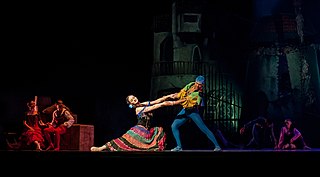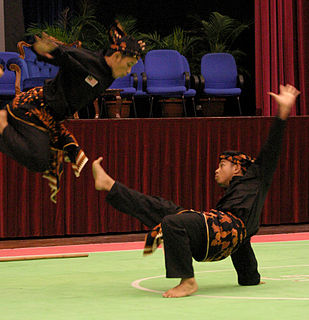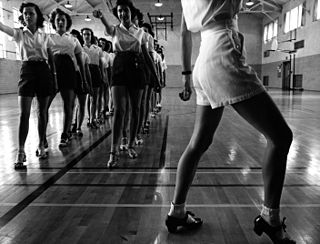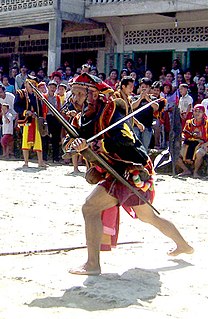Related Research Articles
Musicology is the scholarly analysis and research-based study of music. Musicology departments traditionally belong to the humanities, although some music research is scientific in focus. Some geographers and anthropologists have an interest in musicology so the social sciences also have an academic interest. A scholar who participates in musical research is a musicologist.

Ethnomusicology is the study of music from the cultural and social aspects of the people who make it. It encompasses distinct theoretical and methodical approaches that emphasize cultural, social, material, cognitive, biological, and other dimensions or contexts of musical behavior, in addition to the sound component.
Silat Melayu, also known as Seni Persilatan Melayu or simply Silat, is a combative art of self-defence from the Malay world, that employs langkah ('steps') and jurus ('movements') to ward off or to strike assaults, either with or without weapons. Silat traced its origin to the early days of Malay civilisation, and has since developed into a fine tradition of physical and spiritual training that embodies aspects of traditional Malay attire, performing art and adat. The philosophical foundation of modern Malay Silat is largely based on the Islamic spirituality. Its moves and shapes are rooted from the basis of Silat movements called Bunga Silat, and Silat performances are normally accompanied with Malay drum assembles.

A performance is an act of staging or presenting a play, concert, or other form of entertainment. It is also defined as the action or process of carrying out or accomplishing an action, task, or function.

Music education is a field of practice in which educators are trained for careers as elementary or secondary music teachers, school or music conservatory ensemble directors. Music education is also a research area in which scholars do original research on ways of teaching and learning music. Music education scholars publish their findings in peer-reviewed journals, and teach undergraduate and graduate education students at university education or music schools, who are training to become music teachers.

Pencak silat is an umbrella term for a class of related Indonesian martial arts. In neighbouring countries, the term usually refers to professional competitive silat. It is a full-body fighting form incorporating strikes, grappling and throwing in addition to weaponry. Every part of the body is used and subject to attack. Pencak silat was practiced not only for physical defense but also for psychological ends.

A quadruple reed is a type of reed by means of which the sound is originated in various wind instruments. The term "quadruple reed" comes from the fact that there are four pieces of dried palm leaf vibrating against each other, in pairs. A quadruple reed, such as the Thai pinai, operates in a similar way as the double reed and produces a timbre similar to the oboe. The Arabic pii chawaa is, "sometimes described as having a double reed though this is actually folded yet again, creating four layers of reed and thus requiring considerable lung power to play".

Music psychology, or the psychology of music, may be regarded as a branch of both psychology and musicology. It aims to explain and understand musical behaviour and experience, including the processes through which music is perceived, created, responded to, and incorporated into everyday life. Modern music psychology is primarily empirical; its knowledge tends to advance on the basis of interpretations of data collected by systematic observation of and interaction with human participants. Music psychology is a field of research with practical relevance for many areas, including music performance, composition, education, criticism, and therapy, as well as investigations of human attitude, skill, performance, intelligence, creativity, and social behavior.

Randai is a folk theater tradition of the Minangkabau ethnic group in West Sumatra, Indonesia, which incorporates music, singing, dance, drama and the martial art of silat. Randai is usually performed for traditional ceremonies and festivals, and complex stories may span a number of nights. It is performed as a theatre-in-the-round to achieve an equality and unity between audience members and the performers. Randai performances are a synthesis of alternating martial arts dances, songs, and acted scenes. Stories are delivered by both the acting and the singing and are mostly based upon Minangkabau legends and folktales. Randai originated early in the 20th century out of fusion of local martial arts, story-telling and other performance traditions. Men originally played both the male and female characters in the story, but since the 1960s women have also participated.
Festejo is a festive form of Afro-Peruvian music. The dance is a staple in the Black coastal populations and it celebrates the emancipation of slaves. Festejo is recognized for its high energy and the improvisation carried out by the dancers. Some believe that its origins trace back to competitive dance circles performed by individuals playing cajóns. Despite its African origins, people of all different backgrounds participate in the dance that many regards as one of the greatest representations of Peruvian culture.

Silat (Jawi:سيلت) is a Malay Archipelago indigenous martial art from the Malay Peninsula. It is traditionally practised in Brunei, Indonesia, Malaysia, Singapore, Southern Thailand, Southern Philippines and Southern Vietnam. It was founded in 8th-9th century in Langkasuka. There are hundreds of different styles and schools which tend to focus either on strikes, joint manipulation, weaponry, or some combination.

Dance education is a practice whereby students are taught a broad understanding of dance as an art form or trained professionally in specific dance genres. Dance education also encompasses a research area in which scholars conduct original research on ways of teaching and learning dance. Currently, dance itself is considered an allied form of art and music, thus dance in formal education is closely knit with these disciplines.
Ecomusicology is an area of study that explores the relationships between music or sound, and the natural environment. It is a study which encompasses a variety of academic disciplines including Musicology, Biology, Ecology and Anthropology. Ecomusicology combines these disciplines to explore how sound is produced by natural environments and, more broadly how cultural values and concerns about nature are expressed through sonic mediums. Ecomusicology explores the ways that music is composed to replicate natural imagery, as well as how sounds produced within the natural environment are used within musical composition. Ecological studies of sounds produced by animals within their habitat are also considered to be part of the field of Ecomusicology. In the 21st century, studies within the field the Ecomusicology have also become increasingly interested in the sustainability of music production and performance.

Somatics is a field within bodywork and movement studies which emphasizes internal physical perception and experience. The term is used in movement therapy to signify approaches based on the soma, or "the body as perceived from within," including Skinner Releasing Technique, Alexander technique, the Feldenkrais Method, and Rolfing Structural Integration. In dance, the term refers to techniques based on the dancer's internal sensation, in contrast with "performative techniques," such as ballet or modern dance, which emphasize the external observation of movement by an audience. Somatic techniques may be used in bodywork, psychotherapy, dance, or spiritual practices.

Piring dance is a traditional Minangkabau plate dance originated from West Sumatra, Indonesia and performed both here and Negeri Sembilan, Malaysia. The dance might be performed by a group of women, men or couples, each of them holds plates in each hands, and vigorously rotate or half rotate them in various formations and fast movements.
David G. Hebert is a musicologist and comparative educationist, employed as Professor of Music at Western Norway University of Applied Sciences, where he leads the Grieg Academy Music Education (GAME) research group. He has contributed to the fields of music education, ethnomusicology, sociomusicology, comparative education, and East Asian Studies. Since 2018, he has been manager of the Nordic Network for Music Education, a multinational state-funded organization that sponsors intensive Master courses and exchange of university music lecturers and students across Northern Europe. He is also a visiting professor in Sweden with the Malmo Academy of Music at Lund University, and an honorary professor with the Education University of Hong Kong. He has previously been sponsored by East Asian governments as a visiting research scholar with Nichibunken in Kyoto, Japan, and the Central Conservatory of Music, in Beijing, China.

Indonesian martial arts includes a variety of fighting systems native to or developed in the archipelago of Indonesia, both the age-old traditional arts, and the more recently developed hybrid combatives. In the Indonesian language the term bela-diri is used to mean martial art, and in essence the Indonesian fighting arts are meant as one's defence against perceived threat and assault. Other than physical training, they often include spiritual aspects to cultivate inner strength, inner peace and higher psychological ends.
Tapak Suci Putera Muhammadiyah, shortened as Tapak Suci, is an autonomous silat martial arts organization of Muhammadiyah, the second largest modernist Muslim organization in Indonesia. Tapak Suci is one of the ten 'historic schools' of IPSI, the leading organization of pencak silat in Indonesia.
Embodied writing practices are used by academics and artists to highlight the connection between writing and the body., bring consciousness to the cultural implications of academic writing, and inform an understanding of art forms as first person narrative.
Musical literacy is the reading, writing, and playing of music, as well an understanding of cultural practice and historical and social contexts.
References
- ↑ Mason, Paul H. (2012). "Music, dance and the total art work: choreomusicology in theory and practice". Research in Dance Education. 13: 5–24. doi:10.1080/14647893.2011.651116. S2CID 113427407.
- ↑ Damsholt, Inger. "Choreomusical Discourse. The relationship between Dance and Music". Choreomusical Discourse. The Relationship Between Dance and Music.
- ↑ "Choreomusicology Research Papers - Academia.edu".
- ↑ New choreomusicology article - Jonathan Still, ballet pianist
- ↑ Mason, P.H. (2012). "Music, dance and the total art work: choreomusicology in theory and practice". Research in Dance Education. 13 (1): 5–24. doi:10.1080/14647893.2011.651116. S2CID 113427407.
- ↑ Mason, Paul H. (2014). "Tapping the Plate or Hitting the Bottle: Sound and Movement in Self-accompanied and Musician-accompanied Dance". Ethnomusicology Forum. 23 (2): 208–228. doi:10.1080/17411912.2014.926632. S2CID 194089013.